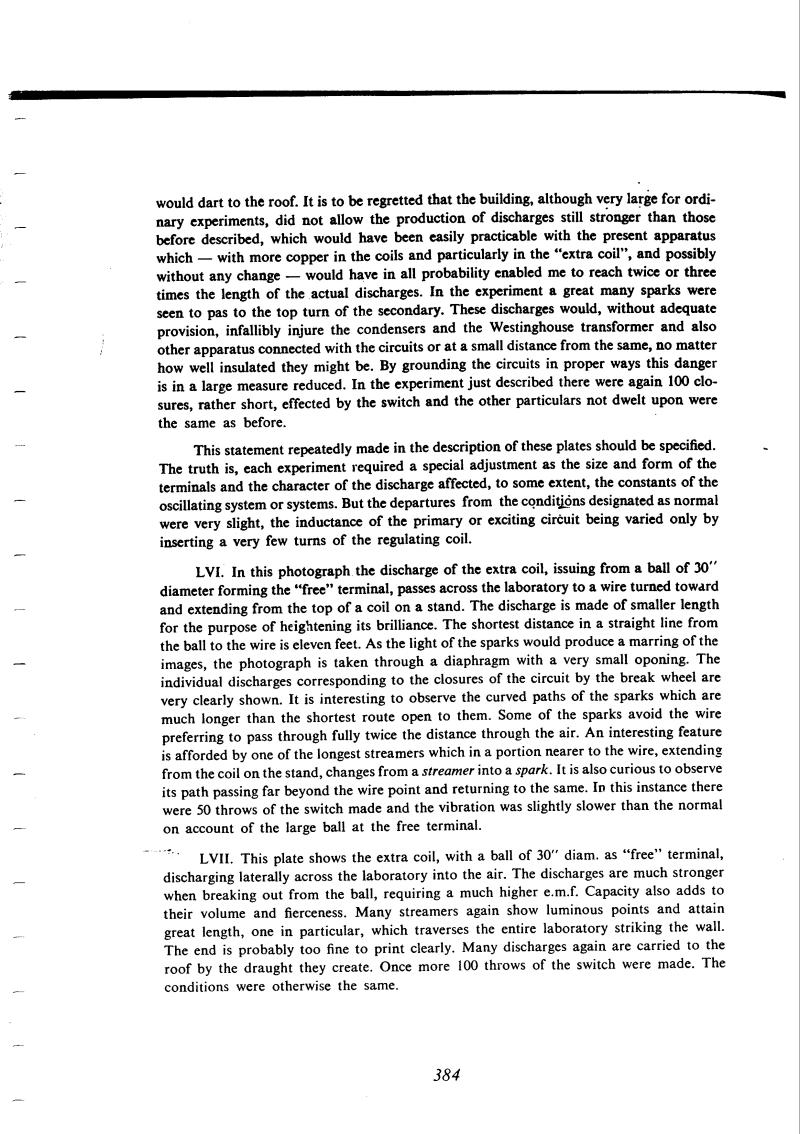would dart to the roof. It is to be regretted that the building, although very large for ordinary experiments, did not allow the production of discharges still stronger than those before described, which would have been easily practicable with the present apparatus which - with more copper in the coils and particularly in the âextra coilâ, and possibly without any change - would have in all probability enabled me to reach twice or three times the length of the actual discharges. In the experiment a great many sparks were seen to pas to the top turn of the secondary. These discharges would, without adequate provision, infallibly injure the condensers and the Westinghouse transformer and also other apparatus connected with the circuits or at a small distance from the same, no matter how well insulated they might be. By grounding the circuits in proper ways this danger is in a large measure reduced. In the experiment just described there were again 100 closures, rather short, effected by the switch and the other particulars not dwelt upon were the same as before.
This statement repeatedly made in the description of these plates should be specified. The truth is, each experiment required a special adjustment as the size and form of the terminals and the character of the discharge affected, to some extent, the constants of the oscillating system or systems. But the departures from the conditions designated as normal were very slight, the inductance of the primary or exciting circuit being varied only by inserting a very few turns of the regulating coil.
LVI. In this photograph the discharge of the extra coil, issuing from a ball of 30" diameter forming the âfreeâ terminal, passes across the laboratory to a wire turned toward and extending from the top of a coil on a stand. The discharge is made of smaller length for the purpose of heightening its brilliance. The shortest distance in a straight line from the ball to the wire is eleven feet. As the light of the sparks would produce a marring of the images, the photograph is taken through a diaphragm with a very small opening. The individual discharges corresponding to the closures of the circuit by the break wheel are very clearly shown. It is interesting to observe the curved paths of the sparks which are much longer than the shortest route open to them. Some of the sparks avoid the wire preferring to pass through fully twice the distance through the air. An interesting feature is afforded by one of the longest streamers which in a portion nearer to the wire, extending from the coil on the stand, changes from a streamer into a spark. It is also curious to observe its path passing far beyond the wire point and returning to the same. In this instance there were 50 throws of the switch made and the vibration was slightly slower than the normal on account of the large ball at the free terminal.
LVII. This plate shows the extra coil, with a ball of 30" diam. as âfreeâ terminal, discharging laterally across the laboratory into the air. The discharges are much stronger when breaking out from the ball, requiring a much higher e.m.f. Capacity also adds to their volume and fierceness. Many streamers again show luminous points and attain great length, one in particular, which traverses the entire laboratory striking the wall. The end is probably too fine to print clearly. Many discharges again are carried to the roof by the draught they create. Once more 100 throws of the switch were made. The conditions were otherwise the same.
384


